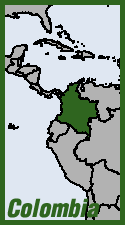 Colombia's government—under pressure from Washington—is pushing ahead with plans to forcibly eradicate 50,000 hectares of coca leaf this year, despite mounting resistance from the peasant growers. In several incidents over the past weeks, forced eradication sparked violent confrontations between cocaleros and security forces. Even so-called "voluntary eradication" is now meeting with protest, as campesinos say their communities are being flooded with National Police troops, in violations of their pacts with the government.
Colombia's government—under pressure from Washington—is pushing ahead with plans to forcibly eradicate 50,000 hectares of coca leaf this year, despite mounting resistance from the peasant growers. In several incidents over the past weeks, forced eradication sparked violent confrontations between cocaleros and security forces. Even so-called "voluntary eradication" is now meeting with protest, as campesinos say their communities are being flooded with National Police troops, in violations of their pacts with the government.
Most recently, cocaleros in the village of Tarazá in the Bajo Cauca region of Antioquia department on Aug. 22 launched a paro, or civil strike, blocking roads and paralyzing the municipality, to demand that National Police troops withdraw from their communities. Tarazá leaders had entered into a voluntary eradication agreement as part of a crop substitution program with the government. Cocalero leaders said they were complying with the agreement to eradicate when police troops were sent in to do it for them.
On July 25, cocaleros at Carmelo corregimiento, Cajibio municipality, Cauca, protested that their community had been invaded by a National Police eradication team backed up by the feared anti-riot unit ESMAD—despite the fact that they had already been voluntarily eradicating in compliance with an accord.
On July 17, clashes with National Police troops left one cocalero wounded at La Tigra vereda (hamlet) in Puerto Rico municipality, Meta department. One police officer was taken captive by the cocaleros and released several days later.
On July 15, clashes were reported from San Miguel indigenous reserve, San José del Fragua municipality, Caquetá.
And some of these police eradication teams are spraying with glyphoste. On Aug. 2, several campesinos faced off with a team of police troops who had been dropped by helicopter to eradicate in Piamonte, Cauca. The troops sprayed glyphosate on coca crops in several veredas of the municipality.
Aerial spraying of glyphosate was finally suspended over health concerns in 2015. The program seemed to be permanently dead when in April Colombia's Constitutional Court ruled against it, finding it violated the precautionary principle. But in May, the high court reversed that decision, finding that aerial spraying is permissible if sufficient control measures are taken. This could clear the way for campesino communities again being sprayed from above.
At the end of August, the Defense Ministry boasted that it had eradicated 29,000 hectares so far this year—60% of the way to its goal.
As the Ministry issued this figure, a group of several Colombian and international civil and human rights organizations issued an open letter to President Juan Manuel Santos, protesting the "intensification" of the forced eradication campaign, and calling upon him to comply with accords made with peasant communities. Signatories included Colombian organizations such as the Corporación Humanas and the DC-based Washington Office on Latin America (WOLA)
But when US Vice President Mike Pence met with Santos in Cartagena Aug. 13, he publicly shamed the Colombian president over the "dramatic" jump in coca cultivation in the country. Personally addressing Santos, he said: "Mr. President, this must end, and this must end soon."
Cross-post to High Times







Recent comments
2 weeks 10 hours ago
5 weeks 5 days ago
9 weeks 6 days ago
10 weeks 4 days ago
20 weeks 4 days ago
24 weeks 4 days ago
25 weeks 5 days ago
25 weeks 5 days ago
46 weeks 5 days ago
50 weeks 6 days ago